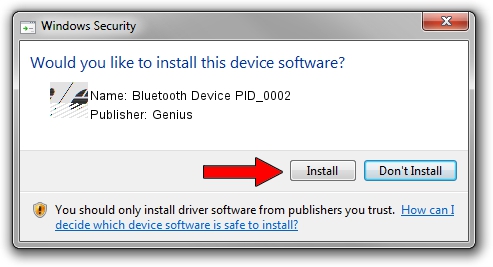- Bluetooth Programming Introduced 2.1. Choosing a communication partner 2.2.1. Device Name 2.3. Choosing a transport protocol 2.3.1. RFCOMM + TCP 2.3.2. L2CAP + UDP 2.4. Port numbers and the Service Discovery Protocol 2.5. Establishing connections and transferring data 2.6. Bluetooth Profiles + RFCs 3. Bluetooth programming with.
- A suitable drivers can improve system performance by 50% or even more. We select more than 160,000 device drivers in the database of Driver Genius, including Motherboard, Sound card, Video card, Network card, Modem, Mouse, Keyboard, Scanner, Printer and Digital devices etc. With one click, Driver Genius will work out all drivers that need updating.
Installing the system’s Bluetooth driver will allow it to connect with various devices such as mobile phones, tablets, headsets, gaming controllers, and more. However, this wireless technology is recommended to be used for transferring data between compatible devices within short ranges.
 -->
-->Important
This topic is for programmers. If you are a customer experiencing Bluetooth device installation issues see Pair a Bluetooth device in Windows
Genius Bluetooth Devices Driver Bluetooth
There are two installation types for Bluetooth profile drivers:
Client-side installation for remote devices where the remote device advertises its services and the computer connects to it. Examples include: mouse devices, keyboards, and printers.
Server-side installation where the computer advertises services and remote devices can connect to the computer to use those services. For example, a vendor could author a server-side installation to enable a PDA to print to a printer attached to the computer.
Genius Bluetooth Devices Driver Wireless
These two installation types require different installation procedures.
Installing a Client-side Profile Driver
A user that wants to use a Bluetooth-enabled device will bring the device within range of the computer and initiate a connection from the computer to the remote device using the following installation sequence for a client-side profile driver.
Launch Bluetooth Devices in Control Panel to find all devices within range of the computer.
Select the device to pair with.
Pair (or bond) the device with the local radio. This may or may not involve a PIN exchange.
The local radio issues an SDP inquiry to identify the services supported on the remote device.
The Found New Hardware Wizard searches for appropriate drivers on the local hard disk drive, and/or on Windows Update.
If the Found New Hardware Wizard does not find an appropriate driver for the device, it prompts the user to insert the profile driver installation media that contains the profile driver's device setup information file (INF file).
Installing a Server-side Profile Driver
The Bluetooth driver stack supports service GUIDs as defined by the Bluetooth SIG, as well as custom GUIDs (that is, GUIDs that are not defined by the Bluetooth SIG).
Note
The Guidgen.exe tool provided with the Microsoft Windows SDK can be used to create custom GUIDs.
A user-mode installation application must be written to expose computer functionality that remote Bluetooth devices can use.
The installation application must communicate with the Bluetooth driver stack to create a service GUID for the functionality to expose. Vendors specify the service GUID in the application and in their device installation INF file.
The installation application must call the user-mode API BluetoothSetLocalServiceInfo. Before the application can call this API the application must have the SE_LOAD_DRIVER_NAME security privilege. The following code example demonstrates how to obtain this privilege. Note that the example does not demonstrate error handling.
Profile Driver INF file
A profile driver's INF file contains information about a Bluetooth device for client-side installation. For a server-side installation, the INF file specifies a device ID that corresponds to the service GUID created by the installation application. All Bluetooth devices are members of the Bluetooth class. The Bluetooth class installer (Bthci.dll) assists in installing profile drivers.
For more information about creating and distributing INF files and installing drivers, see Creating an INF File and INF File Sections and Directives.
Plug and Play IDs
The Bluetooth driver stack generates hardware IDs according to the following templates:
BTHENUM{ ServiceGUID}_VID& nnnnnnnn
BTHENUM{ ServiceGUID}_VID& nnnnnnnn_PID& nnnn
BTHENUM{ ServiceGUID}_LOCALMFG& nnnn
The Bluetooth driver stack generates compatible IDs according to the following template:
- BTHENUM{ ServiceGUID}
ServiceGUID is a 16-bit GUID expanded into a 128-bit GUID, as defined by the Bluetooth specification. For example, {00001124-0000-1000-8000-00805F9B34FB} corresponds to an HID device.
The 8 digits following VID& correspond to the vendor ID code.
The 4 digits following PID& correspond to the product ID code.
The 4 digits following LOCALMFG& correspond to the manufacturer of the local Bluetooth radio.
The VID/PID and LOCALMFG tags are independent of each other.
The most generic device ID is a ServiceGUID by itself. For example:
BTHENUM{00001124-0000-1000-8000-00805F9B34FB}
Genius Bluetooth Devices Driver
The Bluetooth driver stack can be restricted to load your profile driver and software to run only on a specific release of a remote device by using Plug and Play IDs in both the remote device and the INF file. Note that the Bluetooth driver stack generates a VID/PID pair only if the device publishes a Plug and Play ID that the stack can detect using SDP. For example:
BTHENUM{00001124-0000-1000-8000-00805F9B34FB}_VID& nnnnnnnn_PID& nnnn
The Bluetooth driver stack can be restricted to load profile driver and software to run only on a specific local Bluetooth radio by specifying the LOCALMFG tag in the device ID in your INF file. For example:
Genius Bluetooth Devices Driver Updater
BTHENUM{00001124-0000-1000-8000-00805F9B34FB}_LOCALMFG& nnnn
